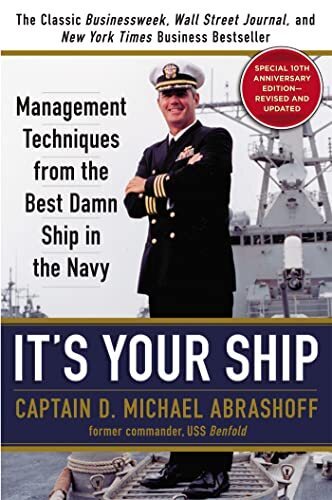
I’m a bit torn on this book. On the one hand, I enjoyed the story of how Captain Abrashoff transformed the USS Benfold from one of the worst to one of the best performing ships in the navy, and I agreed with most of the management/leadership lessons in this book. On the other hand, something about the way those lessons were presented wasn’t sticky or effective.
I think part of the problem is the book tells you what you need to do, but not how to do it. As it turns out, the “what” is fairly obvious, but the “how” is what’s tricky. As an illustration of this, consider the chapters in the book. Each chapter captures one lesson: e.g., Ch 2 is “Lead by Example,” Ch 5 is “Create a Climate of Trust,” and Ch 7 is “Take Calculated Risks.” These are all good ideas, but in some sense, these are all obvious. I would guess most people know that creating a climate of trust or taking calculated risks is a good idea; what most people don’t know is how to actually accomplish that.
As a result, after finishing the book, I walked away with only a handful of new insights, mostly from chapters that had concrete examples or techniques I could apply in my own life:
1. Ownership
“It’s your ship” isn’t just the title of the book, but a refrain that Captain Abrashoff told to every member of his crew. That is, instead of having everyone check every little decision with him, Captain Abrashoff would routinely say, “it’s your ship, you decide, and take responsibility for what happens.” When everyone on a navy ship—or in a company or any other organization—starts to truly think and act like an owner, the results are astounding.
This concept isn’t entirely new to me—I had read about it before in Ownership Thinking and Extreme Ownership—but I found the particular formulation in this book helpful. I’m going to try to tell my own colleagues “it’s your ship” more often, and encouraging them to make decisions and take responsibility for them.
2. Pick up the mic
When Captain Abrashoff first joined the USS Benfold, crew morale was very low. He realized that one of the reasons for this was that the crew felt no sense of purpose: “No one had ever thought to give them a compelling vision of their work, a good reason to believe it was important.”
The solution: define the mission and vision, communicate them clearly, and help each person connect their work to that mission and vision. One of the ways he did this was by “picking up the mic”—literally, the PA system in the ship—and talking to the crew on a very regular basis. It sounds simple, but repeating this sort of message is essential. A CEO at one of my previous companies once told me that, as a leader, the point where you’ve repeated a message so many times that you’re completely sick of it, is just when everyone else has started to hear it for the first time.
3. Build people up
I’ve always had a stereotype in my mind of the military commander who likes to “tear you a new one.” Mistakes are costly, so any time you screw up, you get chewed out.
One thing that stood out to me about Captain Abrashoff is that he took the opposite approach, spending most of his energy on building his crew up, rather than tearing them down. Some examples:
- When it was a sailor’s birthday, he would write a card to that sailor’s family, praising the sailor and his accomplishments. The family would inevitably call that sailor to tell them how proud they were. What a beautiful idea!
- Officers knew they could drop by Captain Abrashoff’s office any time and ask him to praise one of their sailors for specific accomplishments. The Captain would then drop by and have a face to face conversation with the sailor, sharing his sincere gratitude. These conversations cost nothing, were enjoyable for the Captain and the sailor, and the impact on morale was massive. The more he praised his crew, the harder they worked, and the more there was to praise.
- Captain Abrashoff awarded something like ~10x as many medals per year as his official quota. I always worried this sort of thing might dilute the value of a medal, but based on Captain Abrashoff’s results, it seems like there are very few drawbacks, and it’s a huge boost to morale.
4. Have fun
I was also struck by Captain Abrashoff’s focus on allowing sailors to have fun; this is not obvious on something like a military ship! A few examples:
- Captain Abrashoff went out of his way to ensure the ship had good food on a regular basis, and special meals (e.g., lobsters, steak, etc.) on special occasions. It may seem like a small thing, but good food has a strong impact on morale, and sharing meals together is one of the best ways to build camaraderie.
- He allowed sailors to propose ways to have more fun: e.g., projecting movies onto a huge sail; doing karaoke on the ship’s powerful speakers; doing light shows during refueling; relaxing on the deck to watch sunsets while listening to music. These items cost very little, but can be a huge boost to morale.
- He also allowed sailors to take friends and family on board to show off the ship. There’s a special magic that happens when you can take pride in your work and show it off to others.
